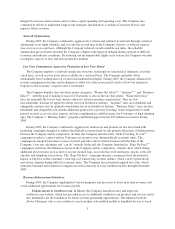Southwest Airlines 2009 Annual Report Download - page 21
Download and view the complete annual report
Please find page 21 of the 2009 Southwest Airlines annual report below. You can navigate through the pages in the report by either clicking on the pages listed below, or by using the keyword search tool below to find specific information within the annual report.DISCLOSURE REGARDING FORWARD-LOOKING INFORMATION
Some statements in this Form 10-K (or otherwise made by the Company or on the Company’s behalf from
time to time in other reports, filings with the SEC, news releases, conferences, Internet postings, or otherwise)
that are not historical facts may be “forward-looking statements” within the meaning of Section 27A of the
Securities Act of 1933, as amended, Section 21E of the Securities Exchange Act of 1934, as amended, and the
Private Securities Litigation Reform Act of 1995. Forward-looking statements are based on, and include
statements about, the Company’s estimates, expectations, beliefs, intentions, or strategies for the future, and the
assumptions underlying these forward-looking statements. Specific forward-looking statements can be identified
by the fact that they do not relate strictly to historical or current facts and include, without limitation, words such
as “anticipates,” “believes,” “estimates,” “expects,” “intends,” “may,” “will,” “should,” and similar expressions.
While management believes these forward-looking statements are reasonable as and when made, forward-
looking statements are not guarantees of future performance and involve risks and uncertainties that are difficult
to predict. Therefore, actual results may differ materially from what is expressed in or indicated by the
Company’s forward-looking statements or from historical experience or the Company’s present expectations.
Factors that could cause these differences include, but are not limited to, those set forth below under “Risk
Factors.”
Caution should be taken not to place undue reliance on the Company’s forward-looking statements, which
represent the Company’s views only as of the date this report is filed. The Company undertakes no obligation to
update publicly or revise any forward-looking statement, whether as a result of new information, future events, or
otherwise.
Item 1A. Risk Factors
The Company’s business has continued to be heavily impacted by fuel prices, which can be extremely
volatile; therefore, the Company’s strategic plans and future profitability are likely to be impacted by the
Company’s ability to effectively address fuel prices.
Fuel price volatility continues to present one of the Company’s most significant challenges, as (i) the cost of
fuel, which has been at historically high levels over the last few years, is largely unpredictable; and (ii) airlines
are inherently dependent upon energy to operate; therefore, even a small change in market fuel prices can
significantly affect profitability.
Fuel prices are unpredictable, in part, because of many external factors that are beyond the Company’s
control. For example, fuel prices can be impacted by political and economic factors, such as (i) dependency on
foreign imports of crude oil and the potential for hostilities or other conflicts in oil producing areas; (ii) limited
refining capacity; and (iii) changes in governmental policies on fuel production, transportation, and marketing.
Likewise, the Company’s ability to react to fuel price volatility can be affected by factors outside of its control.
For example, the Company’s profitability is affected in part by its ability to increase fares in reaction to fuel price
increases; however, fare increases are difficult to implement in difficult economic environments when low fares
are often used to stimulate traffic. The Company’s ability to increase fares can also be limited by factors such as
its low fares reputation, the portion of its Customer base that purchases travel for leisure purposes, and the
competitive nature of the airline industry generally.
Although fuel prices during 2009 were lower overall than in 2008, prices remained much higher than long-
term historical averages. Jet fuel and oil consumed for 2009 and 2008 represented approximately 30 percent and
35 percent of the Company’s operating expenses, respectively, and constituted the second largest expense
incurred by the Company in 2009 and the largest expense in 2008. As a result, the price of fuel has impacted, and
could continue to impact, the timing and nature of the Company’s growth plans and strategic initiatives.
The Company has historically entered into fuel derivative contracts to protect against rising fuel costs;
however, as a result of a significant decline in fuel prices at the end of 2008, the Company significantly reduced
13
























